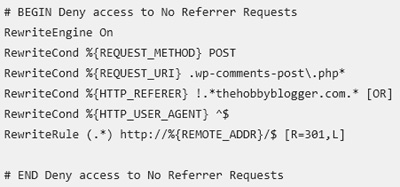7 Kick-Ass Wordpress Tips The Pro’s Use to Combat Spam!
Every month we get great questions from our Business Support members focused on a wide variety of issues. With all the controversy surrounding links and the Google penalties we decided to upgrade the following question to be published so that you could learn from it as well...
"We had a consultation with a client that had closed all commenting down on their blog due to comment spam. As you've advised us in SearchEngineNews, this is going to prevent them from taking full advantage of the Google Freshness Update. What can we do to improve their blog and eliminate as much comment Spam as possible so they feel confident turning commenting back on?"
 Answer: This is a common problem, and it's especially common to those who are relatively
new to blogging in general. It's hard enough to convince clients to add a blog; after a week they log-in and there are already dozens of
spam comments awaiting moderation. Unfortunately, in many cases the client decides to unilaterally turn off comments.
Answer: This is a common problem, and it's especially common to those who are relatively
new to blogging in general. It's hard enough to convince clients to add a blog; after a week they log-in and there are already dozens of
spam comments awaiting moderation. Unfortunately, in many cases the client decides to unilaterally turn off comments.
The result? No comments generated, no repeat pings, and as you mentioned correctly in your question, a very decreased Google Freshness algorithmic impact!
Managing client expectations is VERY important in preventing the above from occurring. You need to advise the client right away that spam comments are a part of having a blog, but they can be managed, and managed effectively.
However, managing expectations is all about preparation. So if you aren't implementing into your client blogs this list of kick-ass Wordpress anti-spam tips, tricks and plug-ins - that needs to stop now!
- 1. Download and Activate Spam Free Wordpress: This is a GREAT plugin that will "almost" eliminate 100% of comment spam in your blog. The best part about this plug-in is its reputation for generating zero false-positives. Our advice is to actually install this plug-in before anything else and give it a test drive for a week or so. If you like it (and we think you will) you probably won't need to do much of anything else. But we don't want to over-sell it, so check out our other recommendations here as well.
- 2. Activate Akismet: Current versions of Wordpress come with Akismet by default. Akismet is a GREAT plug-in and will usually collect a good portion of your comment Spam. Further, each time you use it and label a comment as spam it's sent back to Akismet and they use it to continually refine the plugin. The problem with Akismet is that it routinely collects a lot of non-Spam, so you need to monitor it regularly. To activate Akismet visit your Plugins menu and then follow the request to establish a new API key once you choose a payment plan.
-
3. Add Captcha Verification: There are several Captcha plug-ins available for Wordpress use. We recommend Sweet Captcha not only because it's a great plugin but because it adds an element of fun to the whole Captcha process. Users must do things like drag cigars, musical instruments or wine glasses to animated avatars to verify you are a real person. You can also choose to customize your Sweet Captcha behaviors across six different design categories ranging from movies, to music, to shopping. Captchas are not always user-friendly (since even repeat users will have to add them in every time) but if you want a fun and GUARANTEED way to cut out comment spam, this is it!

- 4. Nofollow Comment Links AND Publicize It By default, Wordpress adds the nofollow attribute to your comment links. At least for new blogs, this is a good idea since it will cut down significantly on comment spam. However, it's also a good idea to publicize that although you are nofollow you will DOFOLLOW specific links that are of significant quality and add to the discussion. A sneaky way to do this is download and install Smart DoFollow which you can automatically configure to dofollow comments of a predetermined length or format. Make sure that you publicize on your blogs a specific commenting policy so users know how and when comments may be approved.
-
5. Disable Trackbacks: A disproportionate amount of comment spam is related to trackbacks. Most blogs don't need to acknowledge trackbacks whereas others may want to individually approve trackbacks on a case-by-case basis. Our recommendation for newer blogs, at least initially, is to disable trackbacks all together per the image below.

You can find this option under your Settings screen and under Discussion. This will turn off trackbacks across your entire site. But, as we mentioned above, if you want to individually manage this you can do this directly from your Edit Post screen on each individual post. Just look for and enable this option below on your posts screen.

6. Block SPAM-Bot Referrer Requests: This is more of an advanced trick and works best if you are on an Apache server and have access to a .htaccess file. A key difference between real users and spam bots is how they access your blog to leave a comment. A real user will almost always send a request to Wordpress through your browser from a specific referring page on which they are looking to leave a comment. A spam bot doesn't do this; it may go directly to wp-comments-post.php and try to leave a comment there, which will result in an "empty referral field" at the browser level. Because your server can detect this empty referral field it can use that information to deny the spam-bot access and send it away without even leaving the comment. To accomplish this, insert the following code into your Wordpress .htaccess file:

7. Fill-out your Comment Blacklist and Moderation Lists: You can find this option under your Settings screen and under Discussion, same place where you managed trackbacks above. It's amazing how many people DO NOT fill out this box. Here's what it usually looks like:

Make sure you populate this for your clients. Include specific keywords based on the comment spam you're observing. Terms like "Viagra" "penis" and "nofollow" are all things you may want to include here. You can also include specific email addresses and names here in case you want to blacklist specific spammers who seem to be visiting your site often.
It's amazing how many times we'll be asked to audit a client's blog and we'll find that they haven't done any of the above. And to be
clear here, ALL of the above are not necessary to cut down your comment spam significantly. Implementing half of the above
recommendations will solve a significant portion of common comment SPAM issues. But you must implement them. It's our opinion that it's
NEVER a best practice to turn off blog comments...ever. Do the above and you'll never have to again.
- Casey Markee, Writer & Lead SEO Consultant, Planet Ocean




